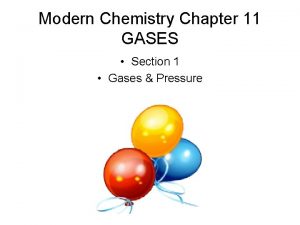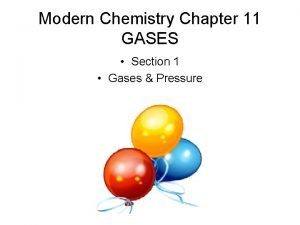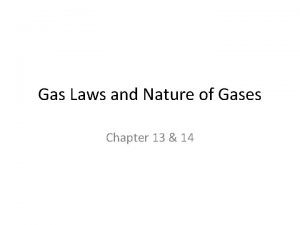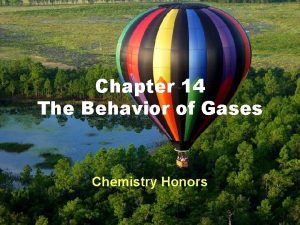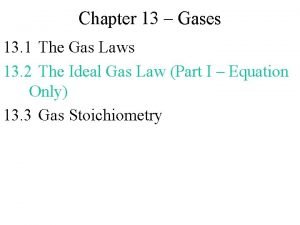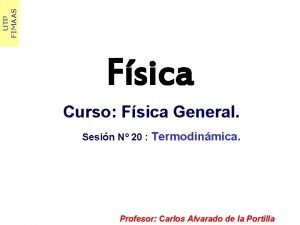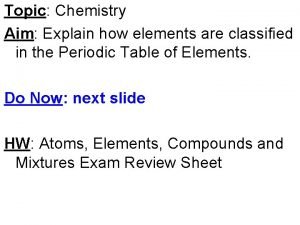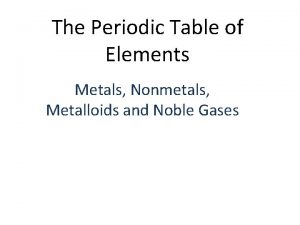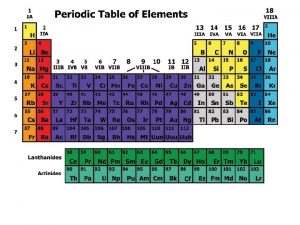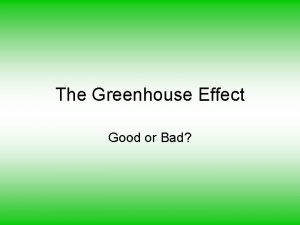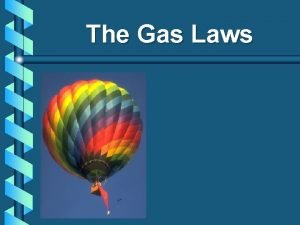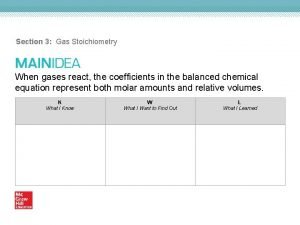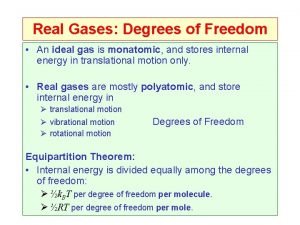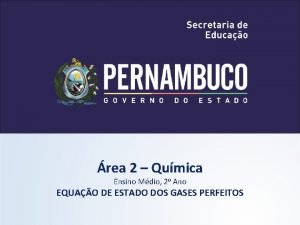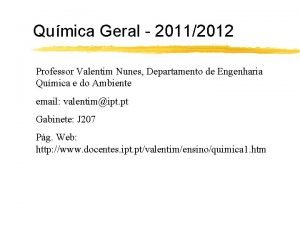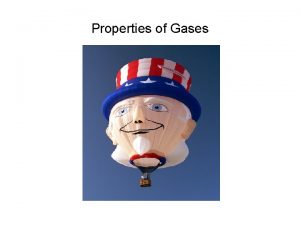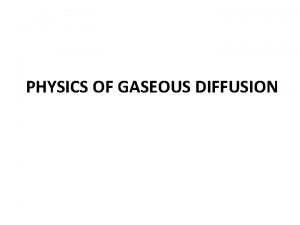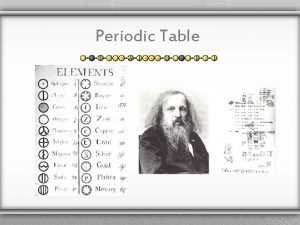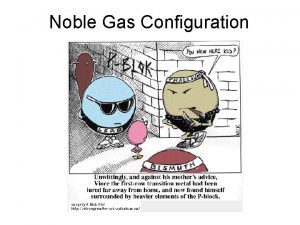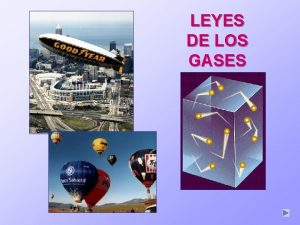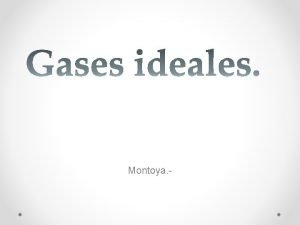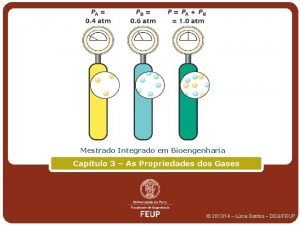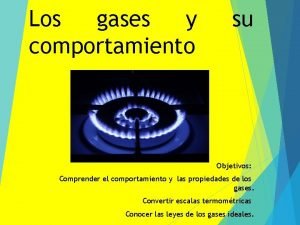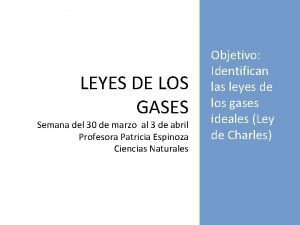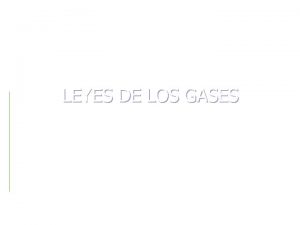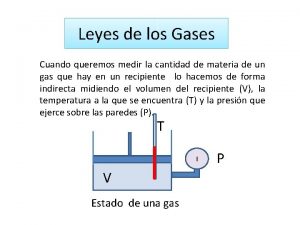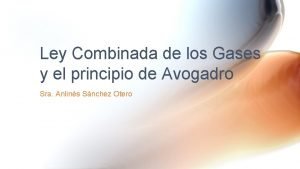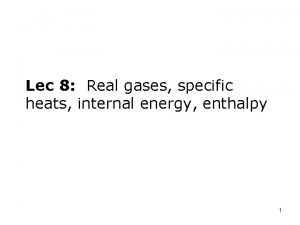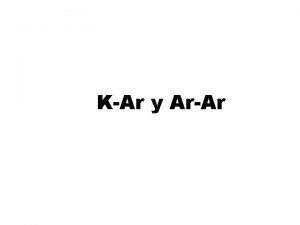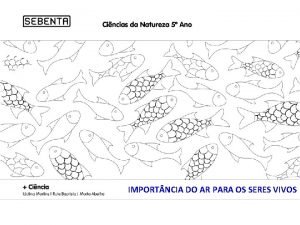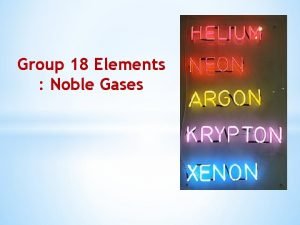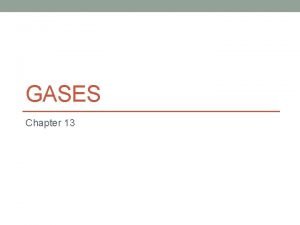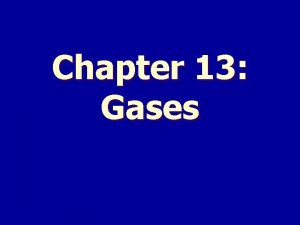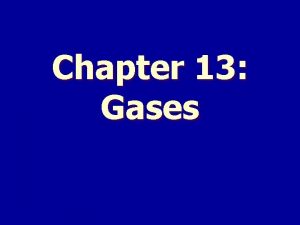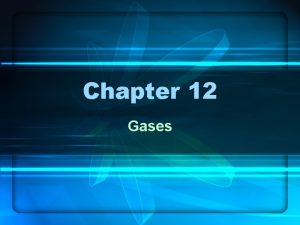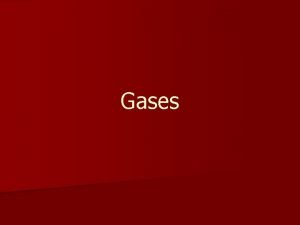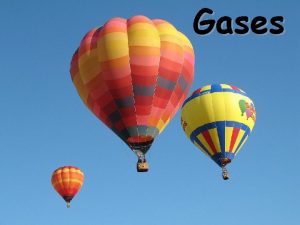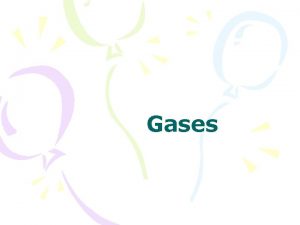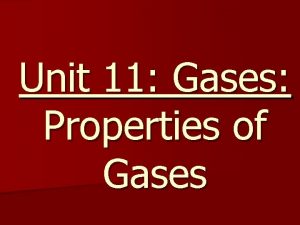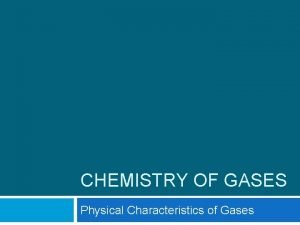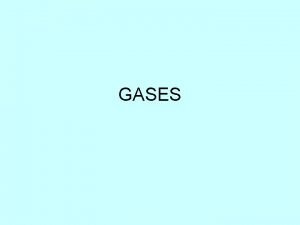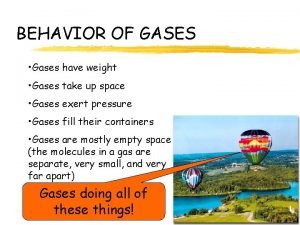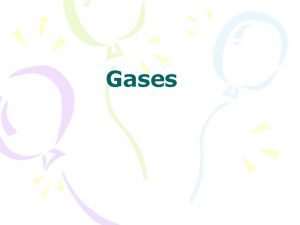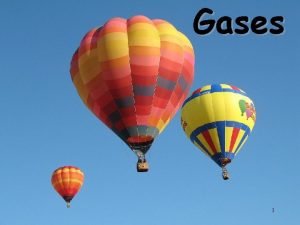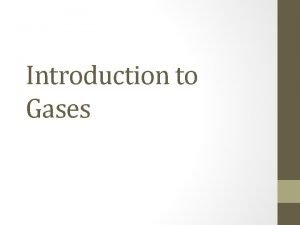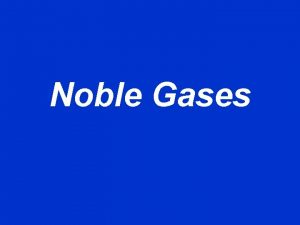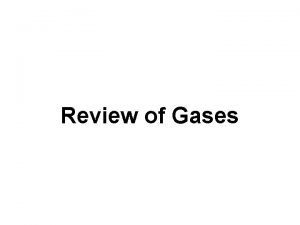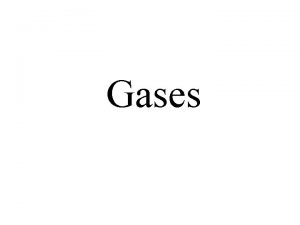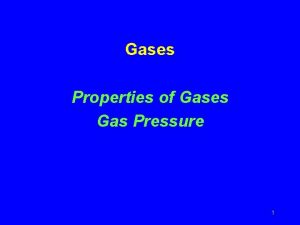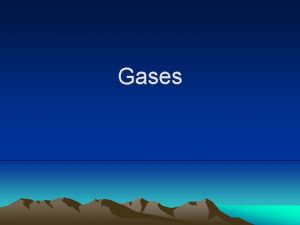Chapter 5 Gases Chapter 5 Gases 5 1








































- Slides: 40

Chapter 5 Gases

Chapter 5 Gases � 5. 1 Substances that exist s gases � 5. 2 Pressure of the gas � 5. 3 The gas laws � 5. 4 Ideal gas equation � 5. 5 Gas stoichiometry � 5. 6 Dalton’s Law of Partial Pressures

5. 1 substances that exist s gases Elements that exist as gases at 250 C and 1 atmosphere


Physical Characteristics of Gases • Gases assume the volume and shape of their containers. • Gases are the most compressible state of matter. • Gases will mix evenly and completely when confined to the same container. • Gases have much lower densities than liquids and solids.

5. 2 Pressure of Gases and its Units � Pressure is defined as the force applied per unit are Pressure = Blaise Pascal Force 2 Area = N/m � The SI unit of pressure is Pascal (Pa) define as one Newton per square meter ( 1 Pa = N/m 2) � Standard atmospheric pressure, the pressure that supports a column of mercury exactly 760 mm high at 0 o. C at sea level. � Measured using a Barometer! - A device that can weigh the atmosphere above us!

Barometer a Barometer! - A device that can weigh the atmosphere above us! A simple manometer, a device for measuring the pressure of a gas in a container

Common Units of Pressure Unit Atmospheric Pressure Pascal (Pa); kilopascal (k. Pa) Atmosphere (atm) Millimeters of mercury (mm. Hg) Torr 1. 01325 x 105 Pa 101. 325 k. Pa 1 atm 760 mm. Hg 760 torr Pounds per square inch (psl or lb/in 2) 14. 7 lb/in 2 Bar 1. 01325 bar Scientific Field Used SI unit; physics, chemistry Chemistry, medicine biology Chemistry Engineering Meteorology, chemistry

Common Units of Pressure Remember the conversions for pressure: 760 mm Hg = 760 torr 1 atm = 760 mm Hg = 101. 325 Pa Convert 2. 3 atm to torr: Example …………………… 2. 0 atm x 760 torr = 1520 torr 1 atm

Worked Example 5. 1


5. 3 The gas laws � Boyle’s � Charles Law , V - P relationship Law , V - T- relationship � Avogadro’s Law , V and Amount

Boyle’s Law : P - V relationship � Pressure � � � � is inversely proportional to Volume P= k or V = k or P V P 1 V 1 = k P 2 V 2 = k’ k = k’ Then : P 1 V 1 = P 2 V 2

Example A cylinder with a movable piston has a volume of 7. 25 L at 4. 52 atm. What is the volume at 1. 21 atm? Given: V 1 =7. 25 L, P 1 = 4. 52 atm, P 2 = 1. 21 atm Find: V 2, L Concept Plan: Relationships: V 1, P 2 P 1 ∙ V 1 = P 2 V 2 ∙ V 2 Solution: Check: since P and V are inversely proportional, when the pressure decreases ~4 x, the volume should increase ~4 x, and it does

A balloon is put in a bell jar and the pressure is reduced from 782 torr to 0. 500 atm. If the volume of the balloon is now 2780 m. L, what was it originally? Given: V 2 =2780 m. L, P 1 = 762 torr, P 2 = 0. 500 atm Find: V 1, m. L Concept Plan: Relationships: V 1, P 2 P 1 ∙ V 1 = P 2 ∙ V 2 , V 2 1 atm = 760 torr (exactly) Solution: Check: since P and V are inversely proportional, when the pressure decreases ~2 x, the volume should increase ~2 x, and it does

Charles’ Law � volume is directly proportional to temperature ◦ constant P and amount of gas � as T increases, V also increases � Kelvin T = Celsius T + 273 �V = constant x T ◦ if T measured in Kelvin

A gas has a volume of 2. 57 L at 0. 00°C. What was the temperature at 2. 80 L? Given: V 1 =2. 57 L, V 2 = 2. 80 L, t 2 = 0. 00°C Find: Concept Plan: Relationships: t 1, K and °C V 1, V 2, T 2 T 1 T(K) = t(°C) + 273. 15, Solution: Check: since T and V are directly proportional, when the volume decreases, the temperature should decrease, and it does

EXAMPLE � Gas occupy 6 L at 370 C what will be its volume when its temperature decreased to the half? V 1=6 L , T 1=370 C V 2=? ? ? , T 2=½ T 1 V 1 T 2=V 2 T 1 V 1½T 1=V 2 T 1 V 2 = ½V 1 V 2 =½(6) = 3 L

Avogadro’s Law � volume directly proportional to the number of gas molecules ◦ V = constant x n ◦ constant P and T ◦ more gas molecules = larger volume � count number of gas molecules by moles � equal volumes of gases contain equal numbers of molecules ◦ the gas doesn’t matter

A 0. 225 mol sample of He has a volume of 4. 65 L. How many moles must be added to give 6. 48 L? Given: V 1 =4. 65 L, V 2 = 6. 48 L, n 1 = 0. 225 mol Find: Concept Plan: Relationships: n 2, and added moles V 1, V 2, n 1 n 2 mol added = n 2 – n 1, Solution: Check: since n and V are directly proportional, when the volume increases, the moles should increase, and it does

5. 4 Ideal Gas Law • By combing the gas laws we can write a general equation • R is called the gas constant • the value of R depends on the units of P and V • we will use 0. 08206 and convert P to atm and V to L • the other gas laws are found in the ideal gas law if two variables are kept constant • allows us to find one of the variables if we know the other 3

Worked Example 5. 3

Standard Conditions � since the volume of a gas varies with pressure and temperature, chemists have agreed on a set of conditions to report our measurements so that comparison is easy – we call these standard conditions ◦ STP � standard pressure = 1 atm � standard � One temperature = 273 K = 0°C mole of a gas occupy 22. 41 L at STP

Example 5 -4 � Calculate the (volume in liters occupied by 7. 40 g of NH 3 at STP � Solution 2 � n NH 3 = 7. 4 / 17 = 0. 435 mol �V = n. RT/P � V = 0. 435 (0. 0821) 273/1 = 9. 74 L � Solution 2 � 1 mole occupy 22. 4 L at STP � 0. 435 mole x >>>>> V = 0. 435 X 22. 4=9. 74 L

EXAMPLE � What is the volume of 2 g O 2 gas at STP � What is the volume of 2 g O 2 gas at 4 atm and 350 C PV = n. RT/P T = 35 +273 = 308 K V = 2 × 0. 0821 × 308/ 32 × 4 V = 2 × 0. 0821 × 273/32 × 1 V = 0. 395 L V = 1. 4 L

Combined Gas Law � When we introduced Boyle’s, Charles’s, and Gay-Lussac’s laws, we assumed that one of the variables remained constant. � Experimentally, all three (temperature, pressure, and volume) usually change. � By combining all three laws, we obtain the combined gas law: P 1 V 1 P 2 V 2 = T 2 T 1


Gas Density � density is directly proportional to molar mass


Molar Mass of a Gas � From density calculations � M = d. RT/ P � From number of moles calculations � n = mass / M � PV= n. RT � PV= (mass / M ) RT


Example 5 -9 �A chemist synthesized a greensh-yellow gaseous compound of chlorine and oxygen and find that its denity is 7. 7 g/L at 36°C and 2. 88 atm. Calculate the molar mass and determine its molecular formula. � Molar mass = d. RT/ P � ℳ = 7. 7 g/L × 0. 0821×(36+273)/2. 88 = 67. 9 g/mol � Mass of empirical formula (Cl. O)= 35. 45+16= 51. 45 � Ratio = Molar mass / Mass of empirical formula = � 67. 9/51. 45= 1. 3 molecular formula. Cl. O 2


5. 5 Gas stoichiometry � Example 5. 11 � Calculate the volume of O 2(in L) requred for the complete combustion of 7. 64 L of (C 2 H 2) measured at the same T & P 2 C 2 H 2 (g) + 5 O 2 (g) → 4 CO 2 (g) + 2 H 2 O (ι) Ø From Avogadro low v= Rn Ø Volume of O 2 = 7. 64 L × 5 L O 2 /2 L C 2 H 2 = 19. 1 L

Example 5. 12 2 Na. N 3 (S) → 2 Na (s) + 3 N 2 (g) Calculate the volume of N 2 generate at 80°C and 823 mm. Hg by the decomposition of 60 g of Na. N 3 § n of N 2 = (60/65. 02) × 3/2= 1. 38 § § PV=n. RT → V=n. RT/P V= 1. 38 × 0. 0821 ×(80+273)/ (823/760) = 36. 9 L

Dalton’s Law of Partial Pressures V and T are constant PA PB P total = PA + PB

Consider a case in which two gases, A and B, are in a container of volume V. n. ART PA = V n. BRT PB = V PT = PA + PB PA = X A PT n. A is the number of moles of A n. B is the number of moles of B XA = n. A + n. B XB = n. B n. A + n. B PB = X B PT Pi = X i PT mole fraction (Xi) = ni n. T


Collecting a Gas Over Water � We can measure the volume of a gas by displacement. � By collecting the gas in a graduated cylinder, we can measure the amount of gas produced. � The gas collected is referred to as “wet” gas since it also contains water vapor. PT = P O 2 + P H 2 O 39 Chapter 11

 Avogadro's law relationship
Avogadro's law relationship Chapter 11 review gases section 1
Chapter 11 review gases section 1 Chapter 14 the behavior of gases worksheet answer key
Chapter 14 the behavior of gases worksheet answer key Chapter 14 behavior of gases
Chapter 14 behavior of gases Section 13.2 the combined gas law and avogadro's principle
Section 13.2 the combined gas law and avogadro's principle Chapter 14 solids liquids and gases worksheet answers
Chapter 14 solids liquids and gases worksheet answers Kinetic molecular theory of solid
Kinetic molecular theory of solid Eficiencia de carnot
Eficiencia de carnot Atomic mass number of boron
Atomic mass number of boron Expansion of solids liquids and gases examples
Expansion of solids liquids and gases examples Periodic table metals nonmetals metalloids noble gases
Periodic table metals nonmetals metalloids noble gases Gases on the periodic table
Gases on the periodic table Is the greenhouse effect good or bad
Is the greenhouse effect good or bad Are gasses highly compressible
Are gasses highly compressible Atmosphere is a mixture of
Atmosphere is a mixture of Solids liquids and gases section 2 properties of fluids
Solids liquids and gases section 2 properties of fluids Stoichiometry of gases
Stoichiometry of gases Venn diagram of solid liquid and gas
Venn diagram of solid liquid and gas Gas exchange in circulatory system
Gas exchange in circulatory system Degree of freedom of an ideal gas
Degree of freedom of an ideal gas Equação gases ideais
Equação gases ideais Equação gases ideais
Equação gases ideais Properties of gases
Properties of gases Diffusion of gases across respiratory membranes:
Diffusion of gases across respiratory membranes: Colour of noble gases
Colour of noble gases 7 noble gases
7 noble gases Fraccion molar gases
Fraccion molar gases Ley de gay lussac año
Ley de gay lussac año Constante dos gases ideais
Constante dos gases ideais Solid
Solid Comportamientos de los gases
Comportamientos de los gases Globo aerostatico ley de los gases
Globo aerostatico ley de los gases Gas ideal
Gas ideal Ecuación general de los gases
Ecuación general de los gases Ley de combinada de los gases
Ley de combinada de los gases Constant specific heats
Constant specific heats Kinetic molecular theory of gases
Kinetic molecular theory of gases Molecular theory of gases and liquids
Molecular theory of gases and liquids Características de los gases nobles
Características de los gases nobles Camadas de ar
Camadas de ar Properties of noble gas
Properties of noble gas
